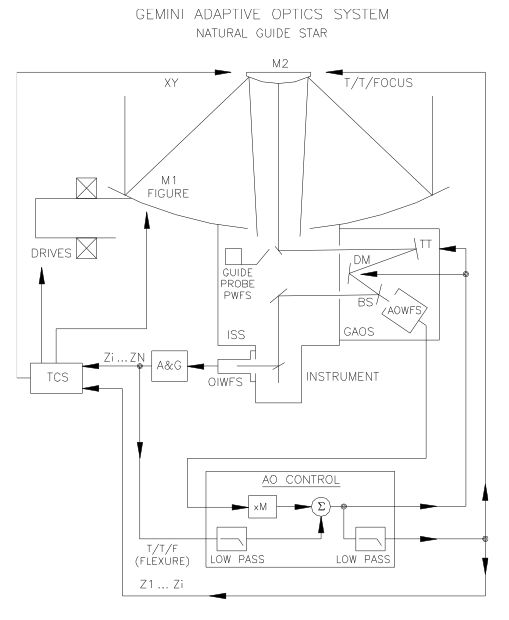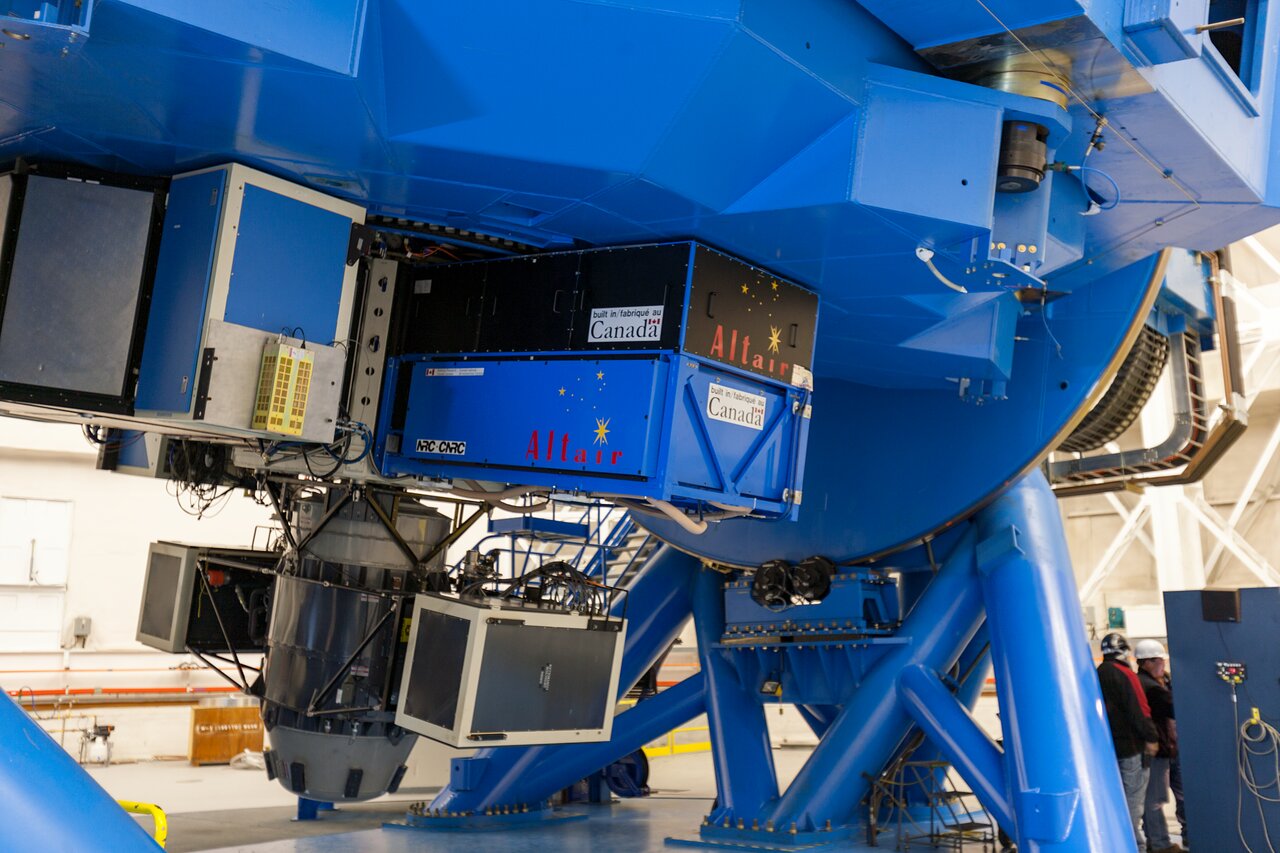ALTtitude conjugate Adaptive optics for the InfraRed (ALTAIR)
ALTAIR on the Gemini North telescope (the black and blue boxes right under the telescope).
Credit: International Gemini Observatory/NSF’s NOIRLab/AURA/J. Pollard
The ALTtitude conjugate Adaptive optics for the InfraRed (ALTAIR) is the facility adaptive optics system built by the Herzberg Institute of Astrophysics in Canada for the Gemini North telescope on Maunakea, Hawai‘i. Adaptive optics applies corrections that allow the optical system to observe finer details of much fainter astronomical objects than is otherwise possible from the ground.
Sophisticated deformable mirrors controlled by fast computers can correct in real time for the distortion caused by the turbulence in Earth’s atmosphere, making the images obtained almost as sharp as they would be if they were observed from space. These distortions are corrected by precisely measuring the distortions in the starlight with a wavefront sensor, calculating the necessary corrections, and implementing those corrections by rapidly flexing the telescope’s adaptive mirrors. This compensates for much of the atmospheric distortion and sharpens the resulting images by a factor of 25–50.
ALTAIR works in the 0.85−2.5-micrometer wavelength range, improving image and spectral data quality when used with the Gemini Near-Infrared Spectrograph (GNIRS).
ALTAIR has three different adaptive optics modes: a Natural Guide Star mode, a Laser Guide Star mode, and a Super Seeing mode, which uses a Laser Guide Star in combination with a peripheral wavefront sensor. In Natural Guide Star mode, Altair uses a Shack-Hartmann wavefront sensor to monitor a natural guide star and partially correct for the atmospheric distortion 1000 times a second with 177 actuators deforming a mirror, a fast tip-tilt mirror, and the telescope secondary mirror. In Laser Guide Star Mode, in the absence of a bright natural guide star near the science target, ALTAIR propagates a laser to excite the sodium atoms present in the upper atmospheric layers 80–90 kilometers (around 50 miles) up, creating an ‘artificial star’. This laser guide star is then used by ALTAIR to measure and correct for the atmospheric distortion, with the exception of the tip-tilt modes which still require a natural star in ALTAIR’s field of view.
The Super Seeing Mode, introduced in 2012, is available for NIRI and GNIRS. When no suitable natural guide star for tip-tilt measurement is present within the ALTAIR field of view, the telescope Shack-Hartmann wavefront sensor is used as a tip-tilt and slow focus wavefront sensor, in parallel with the Laser Guide Star loop. This mode doubles the Laser Guide Star sky coverage and improves the image quality by a factor of two to three over the natural seeing.

Diagram of the ALTAIR adaptive optics system using NGS

Portion of the final K' ALTAIR/NIRI image of the M-82 field.
Credit: International Gemini Observatory/NOIRLab/NSF/AURA
Science Highlights of ALTAIR
- Sakurai’s Object: Stellar Evolution in Real Time
- Next-Generation Adaptive Optics Brings Remarkable Details To Light In Stellar Nursery
- First Directly Imaged Planet Confirmed Around Sun-Like Star
- Charon: An Ice Machine in the Ultimate Deep Freeze
- Gemini Probes The Center Of Andromeda Galaxy With Unprecedented Clarity
- New Gemini Images Exemplify the Power of Adaptive Optics
Quick Facts
|
|
ALTtitude conjugate Adaptive optics for the InfraRed (ALTAIR) For scientists: Please find the most up-to-date details about the instrument offerings on the Gemini website. |
|
|
Site |
Maunakea |
|
Telescope |
Gemini North |
|
Type |
Adaptive Optics Module |
|
Wavelength range |
0.85−2.5 micrometer |
|
Date of first light |
2003 |
|
Images taken with the instruments |
|
|
Images of the instrument |
|
|
Videos of the Instrument |
|
|
Press releases with the instrument |
|
